Neutrino Mystery from Supernova 1987A
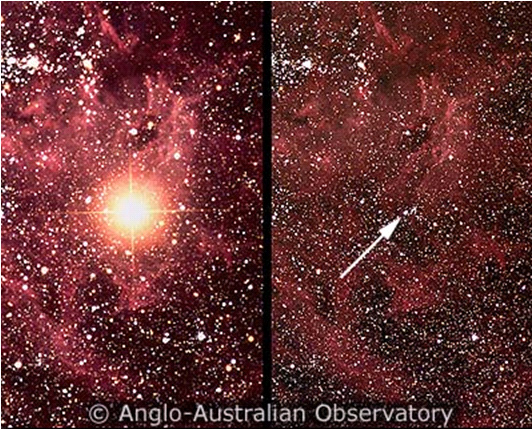
Supernova 1987A: during and before the outbreak
Not so long ago there was a good article Bars21 about neutrinos from supernovae . I really liked it, and some moments (for example, about the urka process) suggested that we not only read or listened to the same teachers, but maybe even know each other personally :)
One of the paragraphs of this article (for a better understanding of what will be said in the future, I recommend to re-read it) was devoted to the registration of neutrinos from Supernova 1987A, and this is the point I would like to add significantly. The fact is that there were not 3, but 4 detectors that registered a neutrino burst, and there were 2 bursts themselves. But this is practically unknown to even the experts, not to mention the general public. All the more insulting that a significant role in this discovery (by the way, was it a discovery?) Was played by Russian (or Soviet, as you like) scientists.
')
And it was like that.
In 1984, with the help of the Soviet-Italian collaboration led by Academician Georgy Timofeevich Zatsepin (his student Vadim Alekseevich Kuzmin mentioned in the original article, for all his merits, was not the main pioneer in this area) the so-called “pioneer” was built in the tunnel between France and Italy under Mont Blanc. liquid scintillation detector (Liquid Scintillation Detector, LSD).
About personalities
Due to the fact that I knew the main characters of this story personally, because of the difference in age, I will magnify everyone by name and patronymic.
Abbreviation, ahem, many people pushed all sorts of frivolous thoughts, but when I asked the professor at the University of Turin, Piero Galeotti, who was credited with the name, he somehow vaguely joked about it.
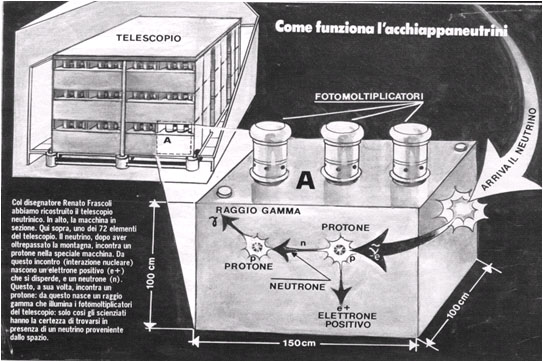
The detector circuit and the main antineutrino reaction underlying its work (the one that was expected during construction)
The detector contained 72 scintillation counters with dimensions of 1 * 1 * 1.5 m in iron containers. A scintillator is a substance, usually on the basis of petroleum products (in our case it was white spirit), in which charged particles generate flashes of light that are captured by photomultiplier tubes. As protection against external radioactivity, iron sheets were placed on all sides of the setup, so that about 200 tons of iron accounted for 90 tons of scintillator. Initially, the main purpose of the installation was to search for neutrino radiation from supernovae.
On February 23, 1987, as early as 2:52 UTC (5 hours earlier than KII, IMB and BUST mentioned in the article Bars21 ), the LSD detector registered the expected signal: 5 events with an energy release of 6–11 MeV, very similar to neutrino interaction , for 7 seconds.
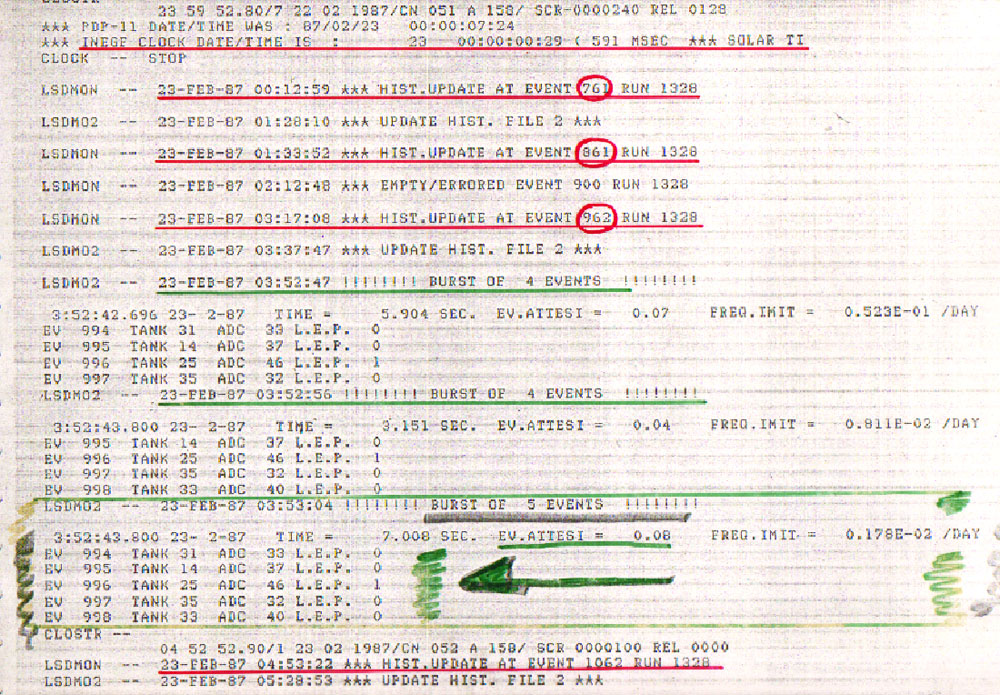
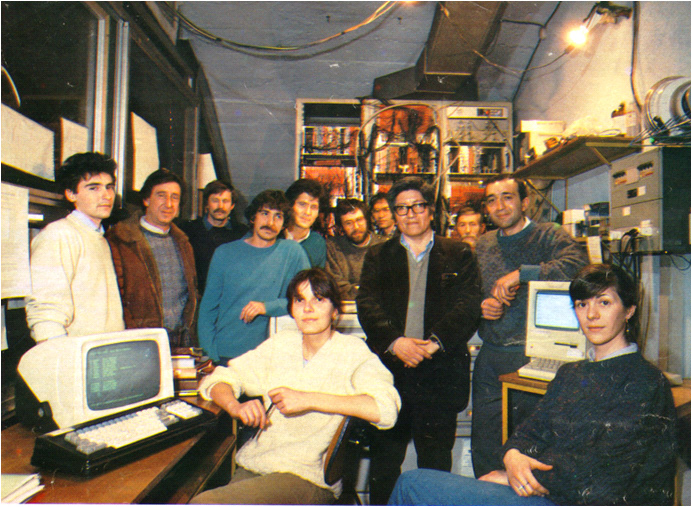
A printout that the team discovered on the morning of February 23, 1987, and this team itself
At 7:36 UTC in LSD, simultaneously with three other detectors, 2 more similar events were recorded with an energy release of 8-9 MeV. During the first signal in LSD, two gravity antennas in Rome and Maryland (USA) worked, which were massive cylinders suspended on thin filaments. Monsters such as the current installations of LIGO or Virgo have not yet built. And in Kamiokande II, a signal was also recorded, consisting of two events.

New chronology;)
But how could a huge detector containing more than 2000 tons of water “lose” by the number of events a small installation with 90 tons of active substance - a scintillator? And where did the second set of events come from? The incident did not fit into the theory of the standard star collapse so much that the signal recorded by LSD was explained as an accidental background event (such as it was, however, was not observed during the entire installation, until 1999), and chose to forget about it. Probably, including the traditional slowness of Soviet scientists, who sought to double-check everything at the moment when it was necessary to forge iron, while hot.
Here it is necessary to delve a little into those conditions under which the standard collapse model is valid. In fact, this is a literal "spherical horse in a vacuum": the star should not rotate, have a magnetic field, but be spherically symmetrical. In the years when this model was developed, the system of differential equations with more complex boundary conditions, I suspect, was simply impossible to solve - even numerically. However, in this model, no one was able to get a reset of the star's shell - what will be perceived by us as a Supernova explosion.
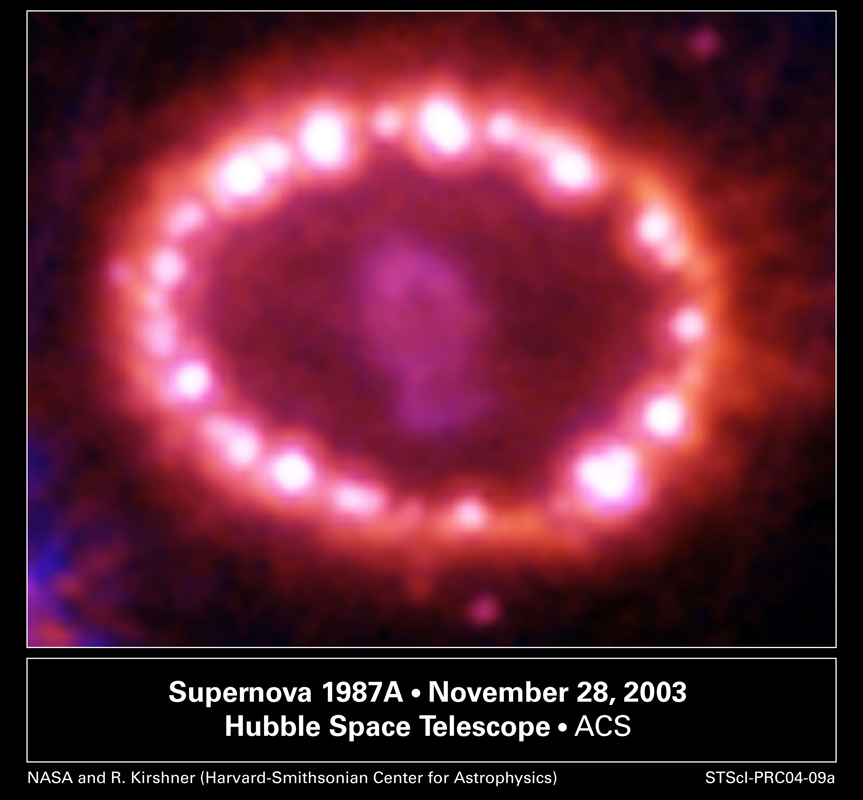
Famous in the circles of astrophysicists image of the residue SN1987A
But in reality, the stars are not spherically symmetric at all and, as a rule, they rotate. Even modern images of the remainder of Supernova 1987A are not at all like a spherically symmetrical picture. So there is every reason to believe that in nature, a supernova explosion occurs due to some more complex processes. But which ones?
In 1995, Vladimir Sergeevich Imshennik, with the help of Dmitry Konstantinovich Nadyozhin, finished developing a model that he called the theory of a rotating collapsar. Its essence is as follows.
If the iron core of a star (and we know that stars are producing atoms from hydrogen starting from helium down to iron, the formation of heavier nuclei is energetically disadvantageous) rotates on the threshold of gravitational compression, which is caused by the "inheritance" of the entire star's rotation and the law of rotational momentum , it follows from the calculations that the period of its rotation is a thousandth of a second. Naturally, the core is flattened axially and instability occurs. A dumbbell emerges from the flattened disc, which is torn apart (in the simplest case, into two). At this moment, electron neutrinos are predominantly emitted (and not neutrinos of all types, as follows from the standard collapse model).
The binary system begins to rotate around a common center of mass, actively emitting gravitational waves, due to which both the energy and the moment of rotation are carried away from the system. The fragments of the nucleus approach each other, so that the moment of mass transfer comes: the lighter component starts dropping the substance to the heavier one, continuing the rotation. When the mass of the light component becomes approximately 10% of the solar one, it becomes unstable and explodes, and the heavier one collapses, presumably according to the standard scenario (this moment personally always seemed to me a big stretch in the whole model).
Despite the fact that the density of matter in the core of the star in both scenarios - a rotating collapsar and a standard one - is close to nuclear, in the second case the temperature in the center of the core is two orders of magnitude higher. Because of this, neutrinos are born with rather high energies - 100–200 MeV, but with such a density of matter, even neutrinos will interact many times. Scattering and re-emitting, neutrinos of all types with energies of 10-20 MeV come to the surface. In the rotating collapsar due to the low temperature, the main reaction of neutrino formation is “indentation” of electrons into protons:
e - + p → n + ν e
The energy of the neutrino in this case will be approximately 30 - 40 MeV, the amount of matter that needs to be overcome by the neutrino, near the polar directions is significantly less. Such neutrinos can reach the surface of the star without interaction, retaining their energy of 30 - 40 MeV.
For the registration of electron neutrinos emitted during the first flash, such nuclei as deuterium, carbon, and heavy neutron rich elements such as iron, lead, and others are well suited. A sufficient number of such elements was available only in LSD (The composition of the BUST also included iron, but there it was relatively small and in a not so successful configuration). Thus, this installation was the only one that could reliably “see” something during the first flash. The interaction of neutrinos with oxygen contained in the water formula would also give several events (it did, but the Kamiokande II team did not advertise this), but much less than iron, if you recalculate the effect per unit mass.
The point is that cobalt and electron are formed as a result of the interaction of the electron neutrino with iron.
ν e + 56 Fe → e - + 56 Co *
The core of cobalt-56 (for purely nuclear reasons) is always born in an excited, non-basic state. This excitation is removed by radiation of one or several gamma quanta. And if the electrons born in the gland may not escape from it, then neutral gamma quanta (with characteristic energies of 1.7, 1.8, 4, or 7 MeV) have greater penetrating power and almost certainly fall into the scintillation layer.
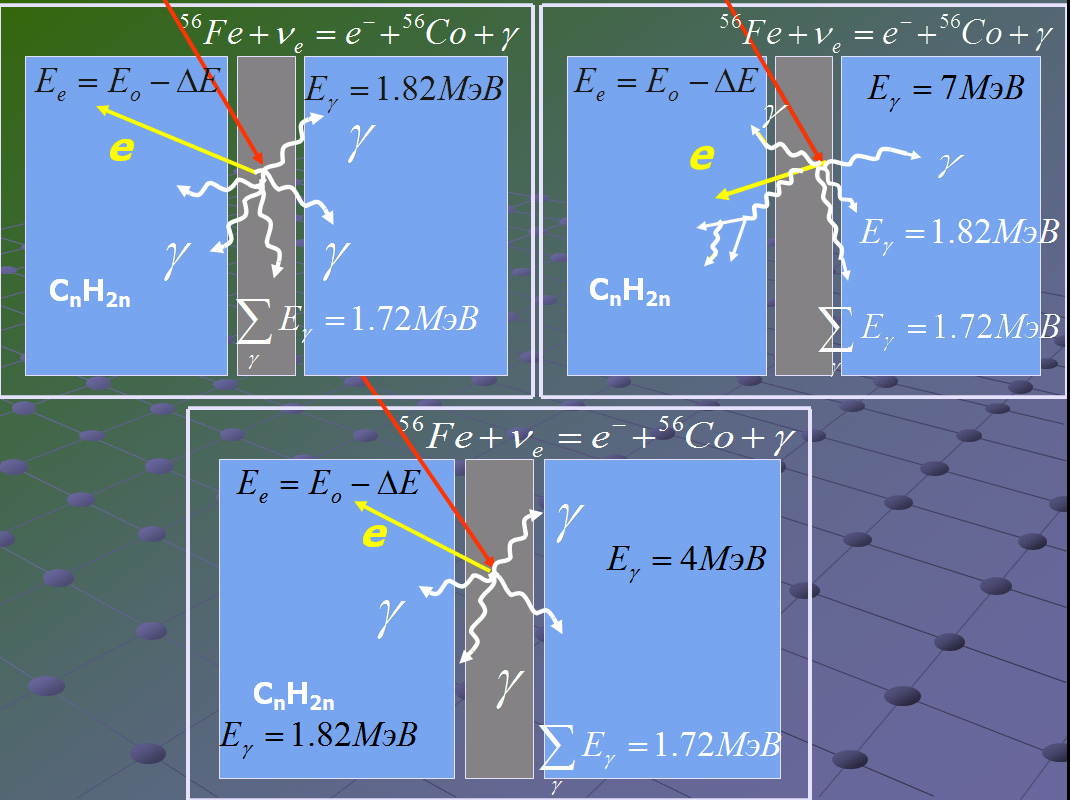
The interaction scheme of neutrinos with iron in the LSD scintillation detector.
The energy release spectrum in the scintillator will be described by the formula dE / E with an additional maximum of about 7 MeV. The main contribution to it will be gamma-quanta from the removal of the excitation of cobalt and gamma-quanta generated by an electron as a result of its inhibition in the gland.
It seemed that the mystery of Supernova 1987A was solved with the help of a rotating collapsar model. Olga Georgiyevna Ryazhskaya, another student of Zatsepin, actually responsible for the course of the LSD experiment from the Soviet side, together with Imshennik, spoke at several conferences trying to convince the world of the discovery (I think its scale was for the Nobel Prize). However, the scientific community’s mistrust of the long-standing result of the LSD experiment was so great (indeed, “as you call a boat, it will float”), and time was lost (it was only possible to compare experimental data with the calculation in the early 2000s, after 15 years after the outbreak itself), so this explanation is not widely accepted. In Russia alone, several more competing theories have been developed, claiming to explain the mechanism of the Supernova explosion and the generation of neutrinos. In the absence of experimental evidence, all these theories remained models or, if you will, no more than hypotheses.
The only conclusion that can be drawn from this story for sure is the need to build such installations that could register not only the “generally accepted” interaction of electron antineutrinos with a proton, but interactions of all types of neutrinos. This requires not only Cherenkov detectors using water or purely scintillation installations, but it is desirable to have a cellular configuration — a sort of neutrino calorimeter with the ability to measure energy — using heavy elements such as iron or lead.

Lvd. For lack of space in the mine, he was always photographed from a single angle and only when there was no other installation in front of him.
A similar installation was the heir to the LSD experiment - the LVD (Large Volume Detector) detector, located in the adjacent hall of the underground laboratory Gran Sasso in the Italian Apeninines, next to Borexino. It contained about 1000 tons of the same scintillator and the same amount of iron as carrier modules and could successfully register up to 1000 purely neutrino events in the event of a Supernova outbreak at the center of our Galaxy. Alas, this phenomenon is quite rare, and over the years of its work (in 2001 it was built completely, but it began observations a few years earlier) to this day it has not been so lucky. I am writing about it in the past tense, because, unfortunately, next year it will be decommissioned according to plan. Perhaps humanity will forever miss the opportunity to unravel one of the mysteries of the universe.
But I still believe in the best.
Source: https://habr.com/ru/post/450620/
All Articles